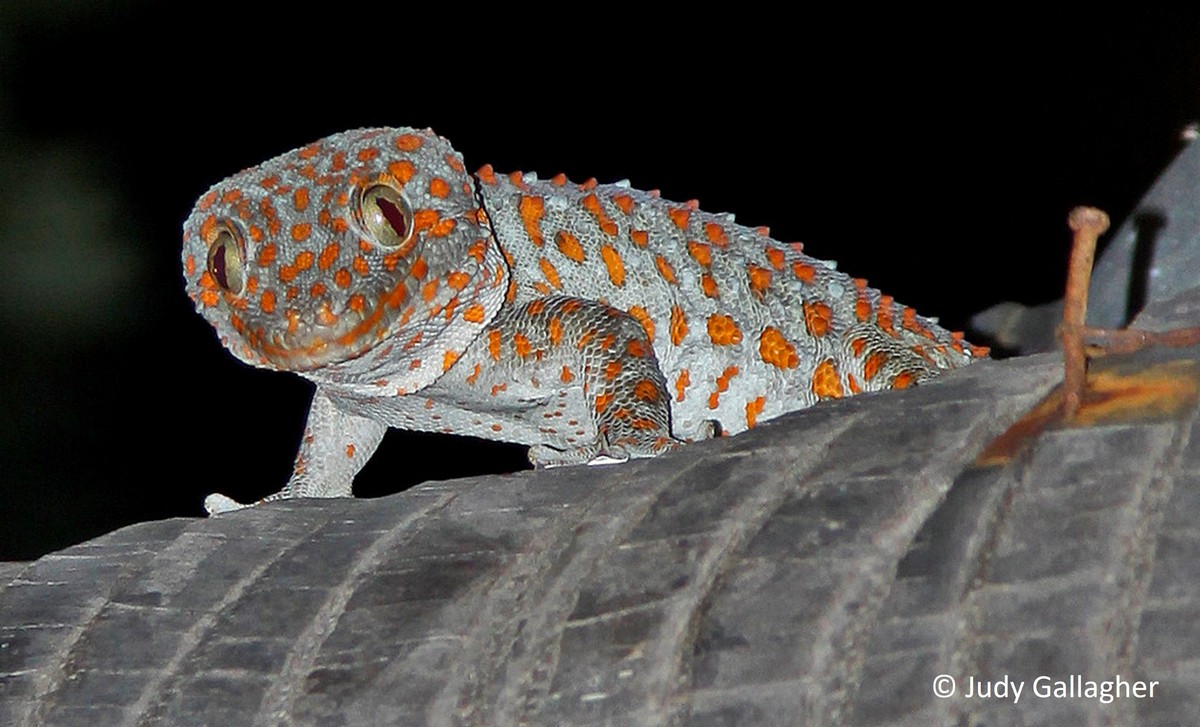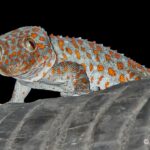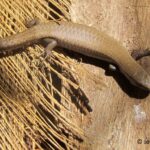
- Common name: Tokay gecko
- Scientific name : Gekko gecko (Linnaeus, 1758)
- Local name: Gecko tokay, Tuctoo, Tokeh-tokeh.
- Order : Gekkonidae
- Family : Squamata
Description
Morphology. The Tokay gecko is a large sized gecko, with a large head and a smooth-looking body, usually bluish-gray with orange dots and light blue spots. The pupil is vertical.
Standard body size (snout-vent length). males: 131 to 170 mm; females: 110 à 152 mm (Meshaka et al., 1997; Aowphol et al., 2006).
Sexual dimorphism. Males are bigger and more brightly coloured than females.
Variations. Body colour can vary from light to dark, under control of the individual.
Possible confusion with other species. In the Lesser Antilles, the Tokay Gecko, due to its large size, colour pattern and very recognisable vocalisations, cannot be confused with other gecko species.
Distribution
Native. North-East India, South-East Nepal, South of Bhutan, Myanmar, Thailand, Cambodia, Laos, Vietnam, Malaysia, South-East China, Hong Kong, Guangxi, Taiwan, Philippines, Indonesia (Rösler et al., 2011; Wood et al., 2020).
Introduced. Florida (Meshaka et al., 1997; Krysko and Daniels, 2005; Krysko and Love, 2016; Behm et al., 2019).
Caribbean: Guadeloupe (Breuil et al., 2009), Martinique (Lorvelec et al., 2007), Curaçao (Behm et al., 2019).
Possible introduction on South Water Caye island, Belize (Meerman et Garel, 2005).
Biology and ecology
Habitat. In natural environment, the Tokay Gecko mainly occupies forest environments (tropical rainforests), but is also abundant in urban areas (Aowphol et al., 2006; Singh and Choudhury, 2016).
Diet. Insectivore and carnivore (Meshaka et al., 1997; Aowphol et al., 2006; Krysko and Love, 2016; Sy et Tanalgo, 2018).
Reproduction. Reproduction occurs at the end of the cold season. Sexual maturity is reached during the second year.
Behaviour. The Tokay Gecko has a large repertoire of powerful vocalisations, which can be heard several dozen meters away, performed during the breeding season or during territorial defence. Males, females, and even juveniles can produce vocalisations (Yu et al., 2011), but typical vocalisations of the Tokay Gecko, consisting of low-amplitude cackles followed by much louder GECK-O syllables, are used by males to attract females (Brumm et Zollinger, 2017).
It is a territorial species, which can be very aggressive in defending its territory or when facing a threat. It typicaly opens its mouth wide for intimidation, and can eventually inflict violent bites if conflict escalates. The Tokay gecko can also feign death when threatened (Lalronunga et al. 2017).
Impact and management of introduced populations
Impact. Little is known about the impact of the Tokay gecko on native ecosystems in introduced regions.
Management. In 2019, the Tokay gecko was included in the list of Appendices II of CITES (Convention on International Trade in Endangered Species of Wild Fauna and Flora), allowing control and monitoring of trade in the species (Sy and Shepherd, 2020).
Bibliographie
- Aowphol, A., Thirakhupt, K., Nabhitabhata, J., & Voris, H. K. (2006). Foraging ecology of the Tokay gecko, Gekko gecko in a residential area in Thailand. Amphibia Reptilia 27, 491–503.
- Behm, J. E., Van Buurt, G., DiMarco, B. M., Ellers, J., Irian, C. G., Langhans, K. E., … Helmus, M. R. (2019). First records of the mourning gecko (Lepidodactylus lugubris Duméril and Bibron, 1836), common house gecko (Hemidactylus frenatus in Duméril, 1836), and Tokay gecko (Gekko gecko Linnaeus, 1758) on Curaçao, Dutch Antilles, and remarks on their Caribbean di. BioInvasions Records 8, 34–44.
- Breuil, M., Guiougou, F., Questel, K., & Ibéné, B. (2009). Modifications du peuplement herpétologique dans les Antilles françaises : disparitions et espèces allochtones. 2ème partie : Reptiles. Le Courrier de La Nature 251, 36–43.
- Brumm, H., & Zollinger, S. A. (2017). Vocal plasticity in a reptile. Proceedings of the Royal Society B: Biological Sciences, 284, 1–6.
- Krysko, K. L., & Daniels, K. J. (2005). A key to the Geckos (Sauria: Gekkonidae) of Florida. Caribbean Journal of Science 41, 28–36.
- Krysko, K. L., & Love, W. B. (2016). Predation by the nonnative Tokay Gecko, Gekko gecko (Linnaeus 1758), on the native Carolina Wren (Thryothorus ludovicianus) and nonnative Cuban Treefrog (Osteopilus septentrionalis) in Florida, USA. Reptiles & Amphibians 23, 44–45.
- Lalronunga, S., Zirkunga, M. C., Zothansanga, C., & Vanlalhimpuia. (2017). Geko Gecko (Tokay Gecko). Death-feigning. Hepetological Review 48, 644.
- Lorvelec, O., Pascal, M., Pavis, C., & Feldmann, P. (2007). Amphibians and reptiles of the French West Indies: Inventory, threats and conservation. Applied Herpetology 4, 131–161.
- Meerman, J. and Garel, J. 2005. Tokay Gecko Gekko gecko. (L) established on South Water Caye, Belize. Accessible sur le site: http://biological-diversity.info/tokay.htm
- Meshaka, W. E. J., Clouse, R. M., & McMahon, L. (1997). Diet of the tokay gecko (Gekko gecko) in southern Florida. Florida Field Naturalist 25, 105–107.
- Rocha, J. C., Piva, A., Batista, J., & Machado, D. C. (2015). Occurrence of the Tokay Gecko Gekko gecko (Linnaeus 1758) (Squamata, Gekkonidae), an exotic species in southern Brazil. Herpetology Notes 8, 8–10.
- Rösler, H., Bauer, A. M., Heinicke, M. P., Greenbaum, E., Jackman, T., Nguyen, T. Q., & Ziegler, T. (2011). Phylogeny, taxonomy, and zoogeography of the genus Gekko Laurenti, 1768 with the revalidation of G. reevesii Gray, 1831 (Sauria: Gekkonidae). Zootaxa 50, 1–50.
- Singh, B., & Choudhury, P. (2016). Habitat preference of Tokay gecko (Gekko gecko) in Barak Valley of Assam, India. Journal of Bioresources 3, 53–59.
- Sy, E. Y., & Tanalgo, K. C. (2018). Predation attempt by Tokay gecko (Gekko gecko) on Olive-backed Sunbird Cinnyris jugularis in the Philippines. Southeast Asian Vertebrate Records, 50–51.
- Wood, P. L., Guo, X., Travers, S. L., Su, Y. C., Olson, K. V., Bauer, A. M., … Brown, R. M. (2020). Parachute geckos free fall into synonymy: Gekko phylogeny, and a new subgeneric classification, inferred from thousands of ultraconserved elements. Molecular Phylogenetics and Evolution 146, 106731.
- Yu, X., Peng, Y., Aowphol, A., Ding, L., Brauth, S. E., & Tang, Y. Z. (2011). Geographic variation in the advertisement calls of Gekko gecko in relation to variations in morphological features: implications for regional population differentiation. Ethology Ecology and Evolution, 23, 211–228.





